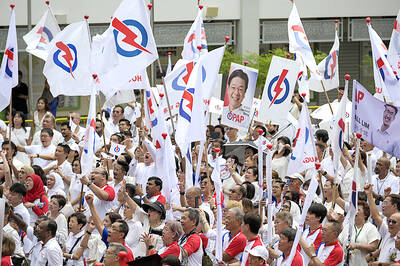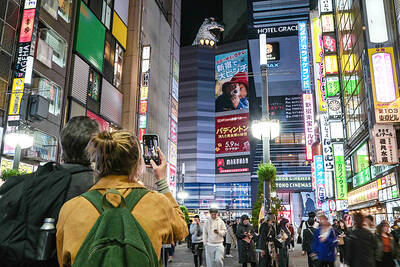The chief UN nuclear inspector said his agency’s Syria probe has been hampered because key satellite images of an alleged nuclear reactor bombed by Israel are inexplicably unavailable on the market.
International Atomic Energy Agency (IAEA) chief Mohamed ElBaradei did not point any fingers on Thursday in the “baffling” failure of his agency’s efforts to obtain the images of the Syrian site immediately after it was bombed by Israel last year.
But diplomats familiar with the IAEA’s Syria investigation said agency officials were considering several scenarios, including the possibility that Syria or other nations with an interest in a cover-up had bought the photos and all rights to them from commercial satellite companies.
ElBaradei’s comments at the start of a two-day full meeting of the IAEA’s 35-nation board partially reflected the focus of the gathering — suspicions about Syria and Iran’s nuclear activities.
On Iran, ElBaradei told the meeting that he “cannot exclude the existence of possible military dimensions to Iran’s nuclear program.”
The US and the EU both expressed alarm at Tehran’s defiance of UN Security Council resolutions meant to curb its suspected nuclear activities. Ali Ashgar Soltanieh, Iran’s IAEA representative, accused Washington and its allies of dragging it before the Security Council as part of a “hidden agenda.”
In the case of Syria, ElBaradei said his “agency was unable to obtain commercial satellite imagery” of the site immediately after the bombing, adding: “It is regrettable, and indeed baffling, that imagery for this critical period ... was not available.”
Syrian nuclear chief Ibrahim Othman was dismissive, telling The Associated Press: “The theory that we bought all the photos is nonsense.”
The IAEA often turns to commercial images beyond any spy satellite photos shared by governments.
But the two nations most likely to have satellite intelligence were unlikely to have provided it with immediate information. Israel still has not confirmed it was behind the strike, while the US waited for more than six months before sharing knowledge with the IAEA.
The possibility that commercial companies simply did not know where to look immediately after the bombing was raised by David Albright, whose Washington-based Institute for Science and International Security closely tracks suspected secret proliferators.
“The United States and Israel went to great lengths to prevent others from finding out where the site was,” said Albright, whose institute was the first to publish commercial satellite images of the site more than a year ago and identify it as a likely North Korean-model nuclear reactor.
“No one knew where the site was immediately after the bombing,” said Albright, whose institute published photos taken nearly a month before the Israeli strike on Sept. 6 last year.
Albright also said that ElBaradei was initially skeptical of the US assertions, which could have led Washington and Israel to withhold satellite photos.
“Why would US intelligence give photos to ElBaradei if he was predisposed not to believe” that they showed a secret nuclear reactor, Albright said in an interview.
Meanwhile, a senior diplomat familiar with the Syria probe suggested that the comments by ElBaradei were at least partially out of date. He said the agency had “very recently” been able to locate commercial images showing the site after the Israeli strike.
IAEA spokeswoman Melissa Fleming said the agency would not comment on the issue.
All of the diplomats asked for anonymity in exchange for speaking to The Associated Press because their information was privileged.

POLITICAL PRISONERS VS DEPORTEES: Venezuela’s prosecutor’s office slammed the call by El Salvador’s leader, accusing him of crimes against humanity Salvadoran President Nayib Bukele on Sunday proposed carrying out a prisoner swap with Venezuela, suggesting he would exchange Venezuelan deportees from the US his government has kept imprisoned for what he called “political prisoners” in Venezuela. In a post on X, directed at Venezuelan President Nicolas Maduro, Bukele listed off a number of family members of high-level opposition figures in Venezuela, journalists and activists detained during the South American government’s electoral crackdown last year. “The only reason they are imprisoned is for having opposed you and your electoral fraud,” he wrote to Maduro. “However, I want to propose a humanitarian agreement that

ECONOMIC WORRIES: The ruling PAP faces voters amid concerns that the city-state faces the possibility of a recession and job losses amid Washington’s tariffs Singapore yesterday finalized contestants for its general election on Saturday next week, with the ruling People’s Action Party (PAP) fielding 32 new candidates in the biggest refresh of the party that has ruled the city-state since independence in 1965. The move follows a pledge by Singaporean Prime Minister Lawrence Wong (黃循財), who took office last year and assumed the PAP leadership, to “bring in new blood, new ideas and new energy” to steer the country of 6 million people. His latest shake-up beats that of predecessors Lee Hsien Loong (李顯龍) and Goh Chok Tong (吳作棟), who replaced 24 and 11 politicians respectively

Young women standing idly around a park in Tokyo’s west suggest that a giant statue of Godzilla is not the only attraction for a record number of foreign tourists. Their faces lit by the cold glow of their phones, the women lining Okubo Park are evidence that sex tourism has developed as a dark flipside to the bustling Kabukicho nightlife district. Increasing numbers of foreign men are flocking to the area after seeing videos on social media. One of the women said that the area near Kabukicho, where Godzilla rumbles and belches smoke atop a cinema, has become a “real

‘WATER WARFARE’: A Pakistani official called India’s suspension of a 65-year-old treaty on the sharing of waters from the Indus River ‘a cowardly, illegal move’ Pakistan yesterday canceled visas for Indian nationals, closed its airspace for all Indian-owned or operated airlines, and suspended all trade with India, including to and from any third country. The retaliatory measures follow India’s decision to suspend visas for Pakistani nationals in the aftermath of a deadly attack by shooters in Kashmir that killed 26 people, mostly tourists. The rare attack on civilians shocked and outraged India and prompted calls for action against their country’s archenemy, Pakistan. New Delhi did not publicly produce evidence connecting the attack to its neighbor, but said it had “cross-border” links to Pakistan. Pakistan denied any connection to